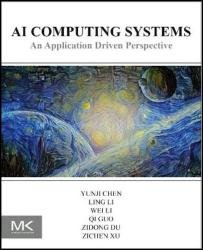AI Computing Systems: An Application Driven Perspective
- Добавил: literator
- Дата: 30-03-2023, 03:22
- Комментариев: 0
 Название: AI Computing Systems: An Application Driven Perspective
Название: AI Computing Systems: An Application Driven PerspectiveАвтор: Yunji Chen, Ling Li, Wei Li, Qi Guo
Издательство: Morgan Kaufmann
Год: 2023
Страниц: 441
Язык: английский
Формат: pdf (true)
Размер: 12.6 MB
The first application-driven textbook for Artificial Intelligence majors featuring software and hardware full-stack penetration.
AI Computing Systems: An Application Driven Perspective adopts the principle of "application-driven, full-stack penetration" and uses the specific intelligent application of "image style migration" to provide students with a sound starting place to learn. This approach enables readers to obtain a full view of the AI computing system. A complete intelligent computing system involves many aspects such as processing chip, system structure, programming environment, software, etc., making it a difficult topic to master in a short time.
Artificial Intelligence (AI), particularly deep learning, is evolving at an incredibly fast pace and has already achieved (or even surpassed) human performance in a number of applications, including image recognition, speech recognition, natural language processing, and video games. It is not exaggerated to say that human beings are stepping into the gate of a great revolution, the AI Revolution. As the physical foundation of all revolutions that happened in human history, like the internal combustion engineto the Industrial Revolution, or the general processor to the Information Revolution, the AI Revolution shall have its own physical foundation. This physical foundation is the AI computing system (AICS).
At the beginning of the Chapter 1, we first introduce the history of AI, which can be boiled down to three main paradigms. Next, we briefly discuss the development of AICS from the very beginning to the near future. Last, we introduce the procedure of adopting AI algorithms for software and hardware implementation on chips, using image style transfer as a driving example.
Neural networks are a subset of Machine Learning. Today, neural networks have become the mainstream of Artificial Intelligence (AI). For example, the aforementioned driving example of this book, i.e., image style transfer, is implemented based on neural networks. The Chapter 2 begins with linear regression and then details the basic principles of Machine Learning, focusing on neural networks. Next, the training process of neural network is described, as well as some optimization techniques to improve training accuracy. The chapter is closed with cross-validation in neural networks.
The purpose of developing AI computing systems is to enable machines to understand and serve humans better. People understand the world mainly by using the senses of sight, hearing, touch, smell, and taste. Among these senses, sight and hearing are particularly important. As for machines, the completion of audiovisual understanding mainly relies on Deep Learning technology. The driving example of this book—image style transfer—also uses deep learning techniques.
In the Chapter 3, we begin with discussing the basic convolutional neural networks (CNNs) for image processing. Then, we detail how to use CNNs to classify images, such as whether the animal in a picture is a cow, sheep, pig, or dog. Image classification is an important benchmark to promote the development of Machine Learning. However, in practice, there would be more than one animal/person/object in a picture. Thus, the principles of typical CNNs for object detection are described, including how these algorithms are developed, which may help readers design new algorithms in this path. Image processing mainly uses CNNs, while sequential information (such as speech, text, and video) processing mainly uses recurrent neural networks (RNNs), or their extension, long short-term memory (LSTM). These models will be detailed in Section 3.4. Last but not least, a relatively novel Deep Learning technology, generative adversarial networks (GANs), will be discussed. GANs not only relieve the demand for massive training data by previous Deep Learning techniques, but also has many interesting applications. For example, Deepfake, a kind of GAN, can not only transfer the style of images and videos, but also swap human heads/faces in them. Some video websites already support face swapping, which replaces the face of an actor in a movie with that of another movie star. Finally, this chapter ends with an implementation of image style transfer.
In the intelligent computing system, the programming framework provides the programmer with the interface to leverage the hardware and the computing system and therefore is the critical part of the intelligent computing system. Google’s TensorFlow is one of the most popular Deep Learning programming frameworks available today, allowing users to use it without taking the underlying CPU and GPU hardware or Deep Learning processor into account. The Chapter 4 first introduces the concept and function of the Deep Learning programming framework. Then, the widely used basic concepts and programming model of TensorFlow are discussed. Finally, the inference and training implementation method of Deep Learning based on TensorFlow is presented through some code examples.
Contents:
Скачать AI Computing Systems: An Application Driven Perspective
[related-news] [/related-news]
Внимание
Уважаемый посетитель, Вы зашли на сайт как незарегистрированный пользователь.
Мы рекомендуем Вам зарегистрироваться либо войти на сайт под своим именем.
Уважаемый посетитель, Вы зашли на сайт как незарегистрированный пользователь.
Мы рекомендуем Вам зарегистрироваться либо войти на сайт под своим именем.

